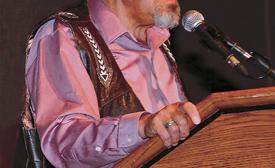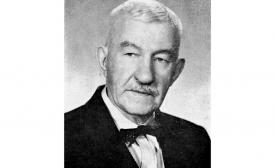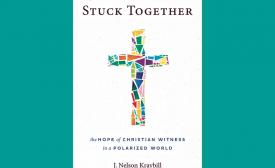Volume 27, Number 8
A centuries-old offer of peace
During the Papal visit to Canada in the summer of 2022, observers and news-watchers likely caught glimpses of banners and heard chants to reject or repudiate the Doctrine of Discovery. For some, this may have been a first introduction to the Doctrine; for others it represented decades of work to bring the Doctrine out of the shadows and into the light.
An assumption of grace

A painting of Christopher Columbus planting his flag in the “New World,” by American artist Louis Prang. (L. Prang & Co., Boston, Public domain, via Wikimedia Commons)

Dave Scott poses with Brandon Burley, mayor of Morden, Man., left, and Cameron Friesen, MLA for Morden-Winkler, at a public event in Morden last summer. (Photo by Robyn Wiebe, courtesy of PembinaValleyOnline.com.)
After the Vatican’s recent repudiation of the Doctrine of Discovery, I spent two hours speaking with three Indigenous people about the 500-year-old church doctrine that is as much the bedrock of Canada as the Canadian Shield.
Readers write: April 21, 2023 issue
The religion of peace
The week the F-35 fighter jet was on the cover (Jan. 30), I had pulled an antique book of sermons off the shelf that my wife had from her grandmother. Published in 1896, it is titled The Message of Peace by R.W. Church. It was written within memory of the U.S. Civil War but prior to the First World War.
Jesus and the 4 Cs
Have you ever heard of the 4 Cs? In education, the 4 Cs refer to 21st century learning skills including critical thinking, creative thinking, communicating and collaborating. In my role now, I have been thinking about how Jesus connects to the 4 Cs, and how they can connect to our work in the church and the world around us.
Bernhard Schellenberg
In 2023, the Mennonite Heritage Archives celebrates 90 years of service to the Mennonite community. It can trace its roots to the Conference of Mennonites in Canada’s annual sessions held June 26-28, 1933, in Gnadenthal (near Plum Coulee, Man.), when Bernhard Schellenberg (1879-1966) was appointed archivist.
‘An old nose’
A recent weekend was exhausting, delightful, enlightening, hilarious, touching . . . and exhausting.
The stars lined up in such a way that we kept our youngest grandchild, seven-year-old Jaxon, here for the weekend. Usually when he’s here, he is accompanied by his two older brothers, but they were busy doing other things.
Dandelions for the Gospel
A dandelion tattoo festoons my left forearm, a puffball ready to launch its wispy seeds. Asked to speak at one of our congregations one Sunday, I intended to start the children’s feature by showing the tattoo.
“Can you do that?” a friend asked. “Can you show a tattoo in church?”
That exchange is object lesson No. 1, and I will let you decide what to take from it.
What more could I want?
“The Lord is my shepherd; I shall not want” (Psalm 23:1).
Despite regular self-reminders of my abundance, I want.
Despite the ongoing conversations with my children about our relative wealth, they want.
Despite overflowing shelves of books and games, and complaining about lack of storage space, and instruments that barely see the light of day, I want.
School’s out
Hundreds of students are preparing to graduate this month from post-secondary institutions supported by Mennonite Church Canada and its regional churches.
First Enneagram Prison Project launches in Saskatchewan
These days, if someone asks, “What number are you?” they are likely not asking your age. The Enneagram, a personality typing system based on nine types, has exploded in popularity over the last 20 years. Now Mennonite Central Committee (MCC) Saskatchewan is helping to bring the Enneagram into correctional facilities.
Nurse practitioner begins theological studies
Although Wendy Dunn had long felt a nudge to pursue theological studies, she never did so until COVID lockdowns at the care home where she worked as a nurse practitioner led her to provide spiritual care in ways she had never expected.
Colony Mennonites threaten Indigenous lands
For many Latin American colony Mennonites, a life of isolation, farming and family is the fulfilment of God’s will, but for others, it is the destruction of sacred lands.
Mennonite leader offers approaches to polarization
Experiences of violence to be overtly named and resisted
Spring 2023 List of Books & Resources
Interest in women’s stories leads to novel about Mary
Getting into the mind of Jesus’ mother inspired a retired psychiatrist to write a novel about what Mary might have experienced during her son’s life.




















